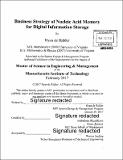Business strategy of nucleic acid memory for digital information storage
Author(s)
De Ridder, Ryan (Ryan James)
DownloadFull printable version (9.427Mb)
Other Contributors
System Design and Management Program.
Advisor
Aleksandra Kacperczyk.
Terms of use
Metadata
Show full item recordAbstract
Nucleic acid memory (NAM) is the storage of digital data by encoding the information into the medium of nucleic acids. This is often called DNA storage, as typically, but not necessarily, the information is stored in the nucleobases that comprise DNA. Baum first introduced this idea in 1995, but it wasn't until 2012 that Church proved the idea on a larger scale. NAM has a number of features that make it very promising as a data storage medium. The three typically highlighted are capacity density, data retention (i.e., durability), and energy usage. NAM should enter the data storage market, as a hardware product, through the ~$4.5B archiving market, by targeting large storage service providers and large data-intensive corporations with on-premise operations. A NAM product has the potential to reduce the capital and operational cost base of these companies, by millions of dollars per year. An architecture strategy should be employed to enter the market, relying on control over underlying ideas and partnerships to barricade the company from competition. NAM is a decade away from commercialization, making this a very risky early stage venture. The costs need to come down at least 100,000-fold before the technology is cost competitive with current solutions. Additionally, there are a number of scientific and engineering issues that need to be carefully resolved. Due to the risks, the only viable funding source is government grants. If early stage funding were secured, IP should be developed in the core NAM technology of storage and access and an interim revenue source established. This would allow the company a strong chance to thrive in the competitive storage industry, if and when NAM becomes cost competitive.
Description
Thesis: S.M. in Engineering and Management, Massachusetts Institute of Technology, School of Engineering, System Design and Management Program, 2017. Cataloged from PDF version of thesis. Includes bibliographical references (pages 62-67).
Date issued
2017Department
Massachusetts Institute of Technology. Engineering and Management Program; System Design and Management Program.Publisher
Massachusetts Institute of Technology
Keywords
Engineering and Management Program., System Design and Management Program.